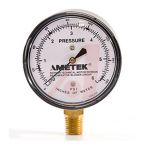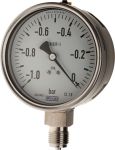Vacuum Gauges
Vacuum Gauges are used to measure pressures lower than ambient atmospheric pressure, which is set as the zero points, in negative values for example -15 psig or -760 mmH equals total vacuum.The inside of a tube which is bent into a circular arc (the so-called Bourdon tube) is connected to the vacuum system. Due to the effect of the external atmospheric pressure, the end of the tube bends more or less during the evacuation process. Operating Temperature of Vacuum GaugeIt is the full-required range of ambient operating temperatures. Temperature and pressure in a system are directly related to each other. If the temperature of the closed operating environment increases, the pressure in the system will increase. In order to prevent equipment damage, it is important to know the extreme temperature ranges of the area.The accuracy of Vacuum GaugeIt is the difference between the true value and the indication expressed as a percentage of the span. It includes the combined effects of method, observer, apparatus and environment.What is Media?Media is the term used to describe the material that surrounds the area of vacuum. Some vacuum gauges measure the pressures of liquids. Others measure the pressures of solids. Devices are also available that are rated for hazardous duty or for unlisted, specialized or proprietary materials.Display type of Vacuum GaugeAnalogue – Analog meters are simple visual indicators using a dialDigital meters – Digital meters are visual indicators with numerical valvesCathode ray tube (CRT) – CRTs are commonly found in computer monitorsLiquid crystal display (LCD) – LCDs are semiconductor light sources using electrons which recombine with electron holes within the device and releasing energy in the form of photonsMulti-line video display – Video displays allow the user to watch and record live feeds of pressure changes in the systemWhere is Vacuum Gauge used?Vacuums are used in many industrial applications such as automotive, nautical, research and development, and manufacturing. They may be used to keep materials moving through the system or to keep the work area clean of pollutants. Gauges and instruments, such as sensors, are an important component to ensure the proper function and safety of the system and equipment. Other typical applications include chemical and petroleum refineries, pharmaceutical, offshore drilling and production, paper mills, fertilizer.






